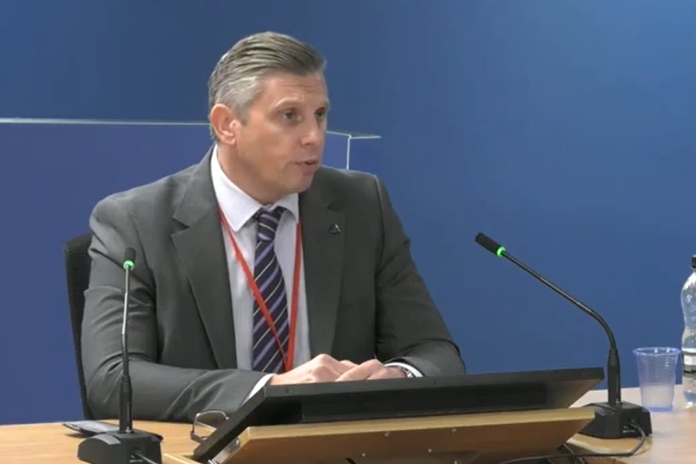
A project manager working for the Kensington and Chelsea Tenant Management Organisation (TMO) during the Grenfell Tower refurbishment has denied a suggestion that what was termed “value engineering” (VE) was really cost cutting.
Paul Dunkerton gave evidence to the Grenfell Tower Inquiry yesterday (12 October).
Dunkerton, a carpenter by trade who had no experience of managing a large and complex refurbishment, explained how he had been brought onto the refurbishment project in 2012 as administrative support to director of asset investment and engineering Mark Anderson. Dunkerton then continued in that role from 2013 under Anderson’s replacement Peter Maddison.
In his witness statement given ahead of the hearing, Dunkerton said he was aware that managing agent Appleyards (also known as Artelia) had begun to look at procurement options as contractor Leadbitter “were proving difficult to work with” and that a VE exercise had started by May 2013. However, Dunkerton said he had no involvement in the exercise.
Counsel to the Inquiry Andrew Kinnier drew Dunketon’s attention to an email he had sent on 27 February 2013 to Alun Dawson of Artelia in which he discussed options for VE. Kinnier asked Dunkerton if he agreed that the email showed that at the least he had views on the scope of the proposed VE exercise.
Dunkerton replied: “Yes, I put forward some suggestions.”
Asked what the scope of his involvement in VE was by February 2013, Dunkerton said he was “more administration” and would put forward suggestions and thoughts about what the TMO could look at for VE.
Kinnier said: “Looking at the list of things that ought to be considered, a lot involved removal of works from the project. Is that a fair overview?”
Dunkerton replied: “Yes, there was consideration of removing some elements of the design.”
Kinnier asked: “Now, would you agree with this proposition: that a VE exercise promotes the substitution of materials and methods with less expensive alternatives but without sacrificing functionality?”
Dunkerton replied: “I wouldn’t say that was specifically the aspects of the VE. I would say, as it suggests there, what could we afford to do, and remove items from the design to bring the project back in line with the available budget.”
Kinnier asked: “Given that answer, what these proposals look like is more akin to cost-cutting rather than VE, isn’t it, Mr Dunkerton?”
Dunkerton said: “Not exactly, no. I would disagree with that. I would say that this was looking at what we could afford to do within the budget and looking at areas that weren’t necessary to achieve the outcomes.”
One of the suggestions Dunkerton made in his email was to “look at alternative material for cladding”.
Kinnier asked if this was Dunkerton’s suggestion or if it came from Maddison.
Dunkerton said: “I think that was already mooted within the project team, as far as I’m aware, and there were various different available types of samples available to residents and the TMO to look at the cladding.”
He added that he could not recall who suggested its use first of all in the meetings he had attended.
When asked if he or Maddison had a particular material in mind, he replied: “Not particularly, no.”
Dunkerton confirmed that ACM cladding was one of a number of different options being discussed at the time. Asked if there was any discussion as to why the alternatives to the zinc cladding originally preferred by architect Studio E were cheaper, Dunkerton said: “Not that I recall.” He also said he could not recall any discussion of the fire safety aspects of the proposed alternatives.
The Inquiry continues.
Comments
Comments are closed.










Again the exposure of the fissures within the complex Overall Management on this Project and the lack of definition of Responsibilities amazes me. Whose role was it to sign off the Variation Orders on the Contract specifying change in detail,materials and associated cost.? (Presumably the Architects). Whose role was it to inform the LA Building Control Department of proposed changes of material and detail under the Building Regulations Plans Approval and get written formal Approval to the detail variation before Construction, Finally was a Building Regulations Completion Certificate issued on this Scheme and if so how did this happen.?
Peter Anderson